

I spent the spring semester of 2009 living in London as part of a study abroad trip to conduct the research for my dissertation. During my four months living in Britain's capital city, I had the opportunity to do some traveling to other parts of Europe on the side, as the cost was relatively inexpensive for someone already located in London. The first one of these side trips came about unexpectedly. I was looking at different travel deals online and I came across an offer to fly to Sweden on a budget airline for a cost of zero pounds. I did a bit of a double-take when I saw that; flights to Sweden for zero pounds?! That had to be a mistake, right? It turned out that the offer was genuine. Ryan Air was offering flights to Sweden for no direct cost at all, only the taxes and fees associated with the flight and those were minimal. As it turns out, there isn't much in the way of tourism to Sweden in mid-February and I was able to advantage of this sweet promotional deal. The airline also made a little extra money by flying into the Västerås airport instead of the main one for Stockholm, forcing everyone to take a bus (also owned by the airline company) on the 110 kilometer / 65 mile ride to Stockholm proper. It was still a great deal either way, and I put together a plan to spend five days traveling in Sweden.


My itinerary had me flying into Stockholm on a Thursday night and spending two nights in the city, then taking a lengthy train ride up to the town of Kiruna in northern Sweden for another two days, before returning back to Stockholm again to fly back to London. I was super excited for this trip and eagerly boarded my outbound flight. The airport in Västerås was a tiny affair, one of those little hole-in-the-wall airports with only four or five gates total for arriving and departing planes, and no chance for anyone to get lost. I was also amused that this airport only had a unisex bathroom, something that simply doesn't exist in the United States. The bus ride to Stockholm took a little over an hour to arrive, and it deposited me in the center of the city at about 10:00 PM local time. I had a bit of a hike to get to my destination for the evening, the Långholmen hostel, built on the site of a former prison. This was a highly unusual place to stay for a night, and it wasn't crowded at all by virtue of the wintry season. While I was walking there, I stopped to take a picture of the Stockholm downtown in the soft glow of the nightime lamps... and suddenly realized that I couldn't find my camera. A frantic search turned out to be in vain: I had lost my camera somewhere along the way.  I think that I left it on the bus from the airport, but I would never see that camera again. As such, I would end up having to use disposable cameras for this trip and that would limit how many pictures I was able to take. The images also came out with a faded, washed-out look that make it seem as though I was visiting Sweden in the 1970s. This still remains a huge regret of mine, moreso the lost opportunity to take more and better quality pictures on this trip than the cost of the camera itself. What a shame.
I think that I left it on the bus from the airport, but I would never see that camera again. As such, I would end up having to use disposable cameras for this trip and that would limit how many pictures I was able to take. The images also came out with a faded, washed-out look that make it seem as though I was visiting Sweden in the 1970s. This still remains a huge regret of mine, moreso the lost opportunity to take more and better quality pictures on this trip than the cost of the camera itself. What a shame.
As such, I have no pictures of the Långholmen hostel. I didn't spend much time there regardless, arriving around 11:00 PM and leaving by 7:00 AM the next morning. I raced back to the bus station in the hopes of finding my camera there in a lost and found section, but not surprisingly never came up with anything. The day had dawned cold and overcast, with light flurries of snow falling throughout the morning. Much of the harbor in Stockholm remained frozen over in ice, with snow then layering on top in a thin white blanket. I was heading for the ferry terminal at Strandvägen, with the plan to take a boat out into the Stockholm archipelago on this first day in the city.

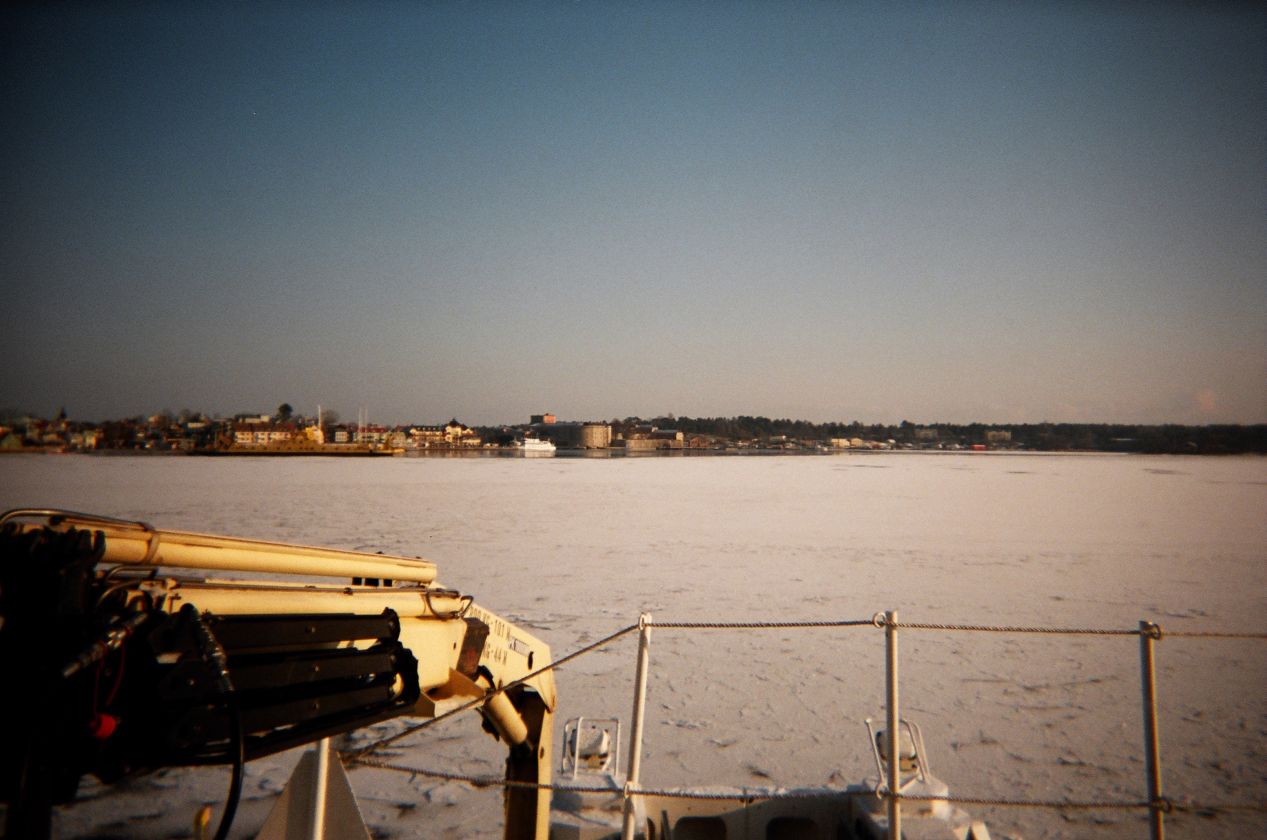


That's the ferry that I ended up taking in the first picture above. I'd had a devil of a time while planning this trip trying to read a ferry schedule that was written entirely in Swedish, and intended only for local transit so therefore having no translation options. I was heading out into the Stockholm archipelago, an array of thousands of small islands along the Swedish coast of the Baltic Sea located a short distance to the east of the city center. It would take a couple of hours to reach the island that I'd picked to see this day, and then a few hours to return back again. The ferry itself was designed for utilitarian purposes, not uncomfortable by any means but hardly luxurious. I spent a while watching the scenery pass by outside the windows, once or twice heading outside to take in the views more directly. It was too cold to spend much time outside, however. Sometimes the ferry passed through channels of open water, while at other points in time our path had chunks of broken ice, and at still other moments the ship had to break the ice itself where the water had frozen solid. Soon the ferry left the civilized comforts of Stockholm behind and the scenery outside become more and more natural, heading out into land that was covered with forests. I always love moments like this when traveling, heading off for unknown destinations with the feel of adventure heavy in the air.

I was headed for an island named Gällnö, which the locals pronounced like "Yall-Know" with a soft "G" at the front of the name. I circled its location on the map above, an irregularly-shaped piece of land out in the middle of the Stockholm archipelago. This place is obscure enough that it doesn't have a Wikipedia entry, but a website called the Archipelago Foundation described it as "a typical island of the central archipelago, with a well preserved pastoral landscape and settlements." That was more or less what I had found out before leaving as well, based on a very limited search of online materials. Gällnö appears to be a quiet summer retreat for people living in Stockholm, a place to visit peaceful farmland and stay at the summer camp located on the island.

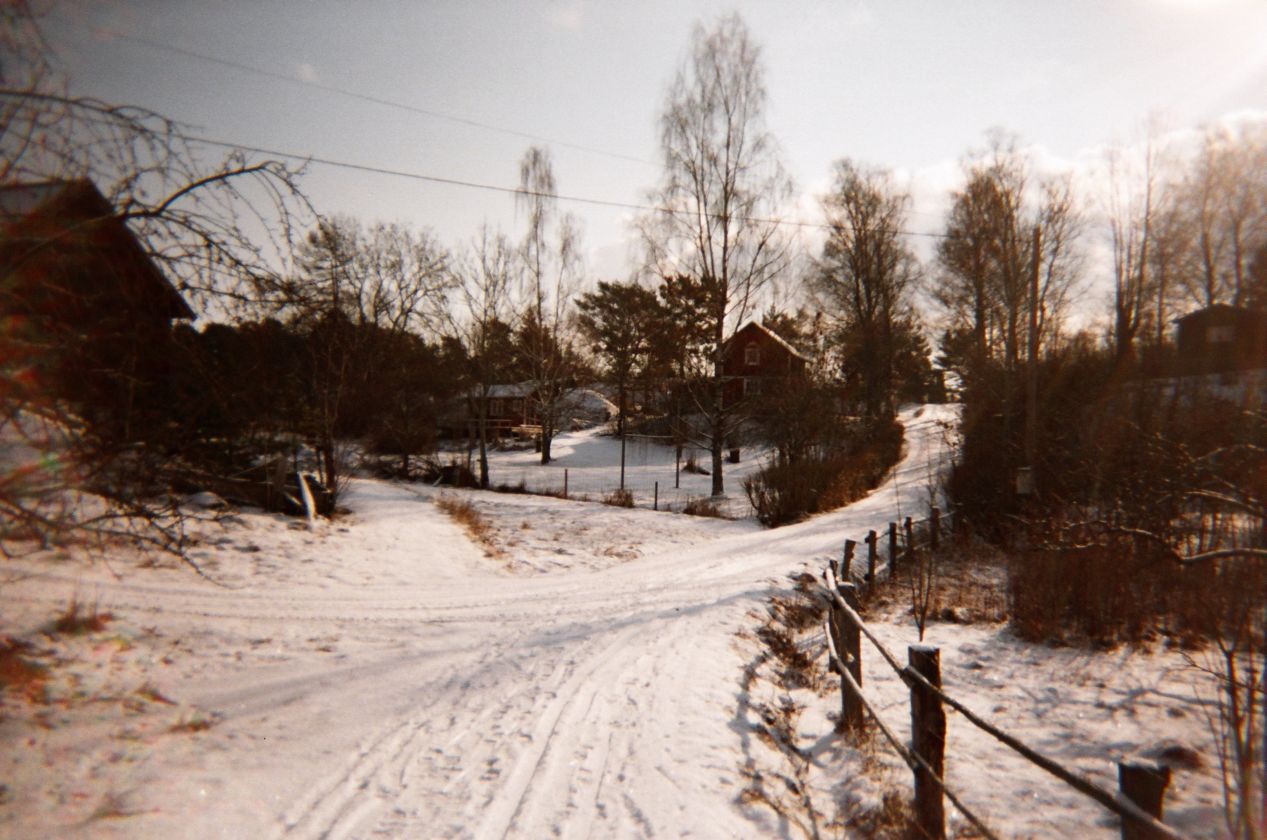


Needless to say, everything looked a lot different in February than it would have looked in the summer months. Only two other passengers left the ferry along with me, and we disembarked onto a snow-covered island that seemed to be deserted. There weren't really any roads on Gällnö, just walking paths, and I began hiking along the main path to see where it led. I found myself passing by several dozen houses, none of which seemed to be occupied at the moment. They looked like very nice summer houses, and I suspect that their owners didn't spend much time out here on the island when snow was on the ground. Nearly all of them had saunas outside in separate little buildings; yes, this was definitely Sweden, heh. The whole place was charming, right down to the little wooden sign at a crosroads indicating what lay in each direction down the path. I imagine that this all would have been lovely in the summer when the weather was warm and the houses were full of visitors. It was still quite pretty in the winter with the snow coating the fields and the trees, just a little bit creepy with no one else around.

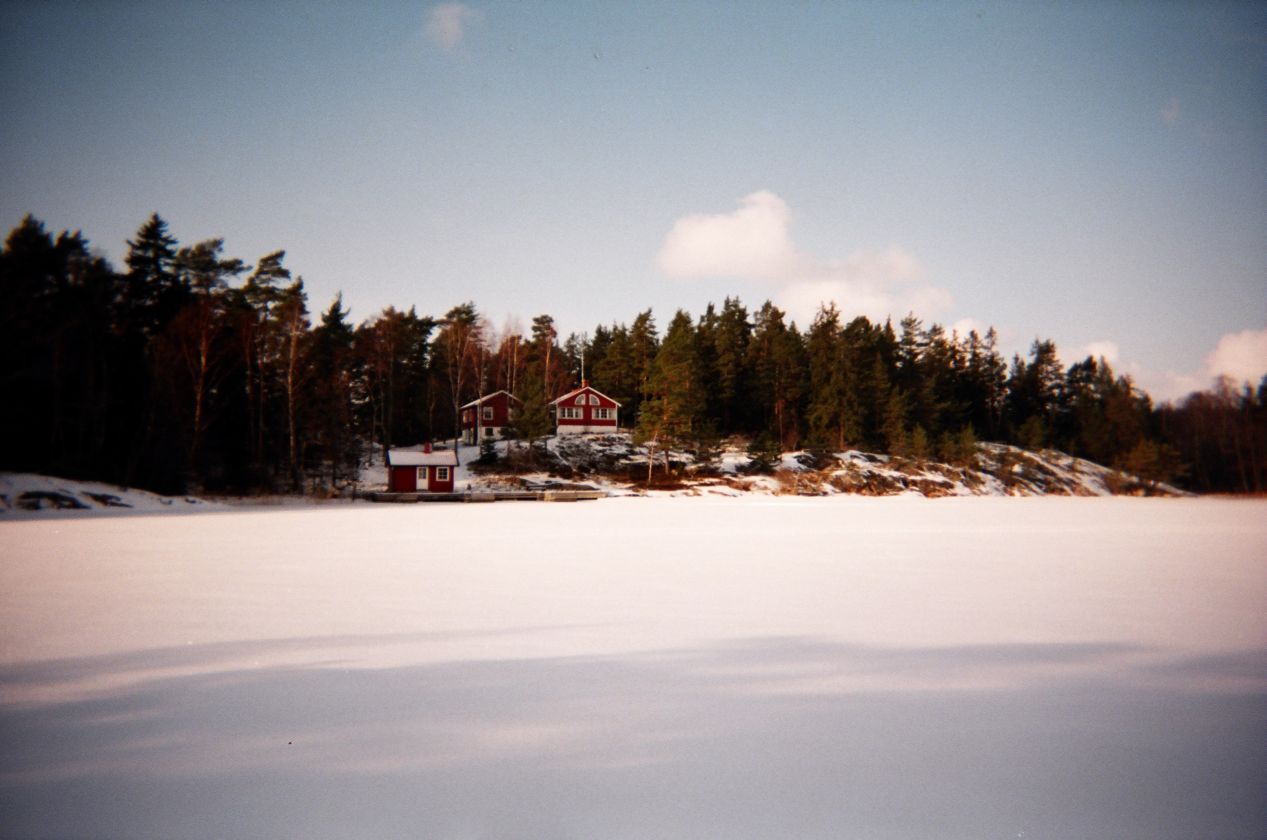


I had landed on the southern side of the island where the ferry had a small dock. The northern side of the island was a bit more rugged, with fewer houses and more trees lining each side of the path. This was an area that appeared to be even more deserted, and no one seemed to have come this way in weeks, if not months. The path curved down to run alongside the water's edge, and I was struck with an idea: what if I walked across to the island on the other side of the narrow channel? It was a profoundly stupid idea, as there was no one in miles around to help me out if the ice would break and I were to fall into the freezing water underneath. At the same time though, this was the thickest time of the year for ice accumulation and I reasoned that I could take my time and be careful in the process. And besides, when was I ever going to get a chance to walk from one island to another island in the Stockholm archipelago by crossing on the ice? Dumb as it was, I had to give this a try.
Crossing that ice was probably the slowest that I've ever walked in my life. I would take one step forward, holding all of my weight back on the other foot, and gently test to see if the ice ahead would support me without cracking. Wait a few seconds, then gingerly take another step forward, and so on. I took it slow and steady and never ran into any issues. Honestly, that ice had been there all winter and I probably could have driven a car over it without any problems. The pictures above are from my initial view out across the ice, another picture halfway between the islands, and then a final image looking back to where I had initially started while standing on the second island. It was only about the length of a football field from one side to the other, and I successfully made it across and back again. What a fun travel story to tell!


I walked to the eastern edge of the island afterwards without finding much more of interest. There was another tiny dock there where the ferries landed in the summer and that was about it. I walked back from there to the place where I had arrived earlier in the day, making sure to get there a full hour ahead of time to be safe. I wasn't entirely sure that I had read the ferry schedule correctly since it was in another language, and the last thing that I wanted was to be stranded on a deserted island in frigid weather. The sun was beginning to set over the ice-strewn waters when the ferry finally arrived again. I was the only one on the dock this time and it had been a lonely wait. I was extremely glad to see that ship appear, let me tell you. I ended up sleeping much of the return trip back to Stockholm, thoroughly tired from hiking around during the day and operating on not much sleep from the previous night. Back in the city proper, I ate a quick dinner and headed to my hostel for the night. This one also had a distinctive shape: some of the rooms in the hostel were located on a ship in the harbor.


That first picture above is the ship where visitors could stay overnight. Known as the Vandrarhem af Chapman, this hostel was located on the small island of Skeppsholmen in the middle of the downtown part of the city. I did not sleep on the ship itself, since that was significantly more expensive, instead staying in a big commnual barracks in a building on the island itself. One of the stories that I like to tell about this particular night's stay is that I checked in on the progress of my team in the Apolyton Demogame which was ongoing at the time, and found that it was exceedingly difficult to write a post on our team forum because the Swedish keyboard that I was using lacked any apostrophe keys.  Fun times. This was a great place to stay for the night regardless, with Skeppsholmen right in the middle of the city and with great views looking out across the water in every direction. I would definitely recommend this place to other young travelers exploring the city on a budget.
Fun times. This was a great place to stay for the night regardless, with Skeppsholmen right in the middle of the city and with great views looking out across the water in every direction. I would definitely recommend this place to other young travelers exploring the city on a budget.

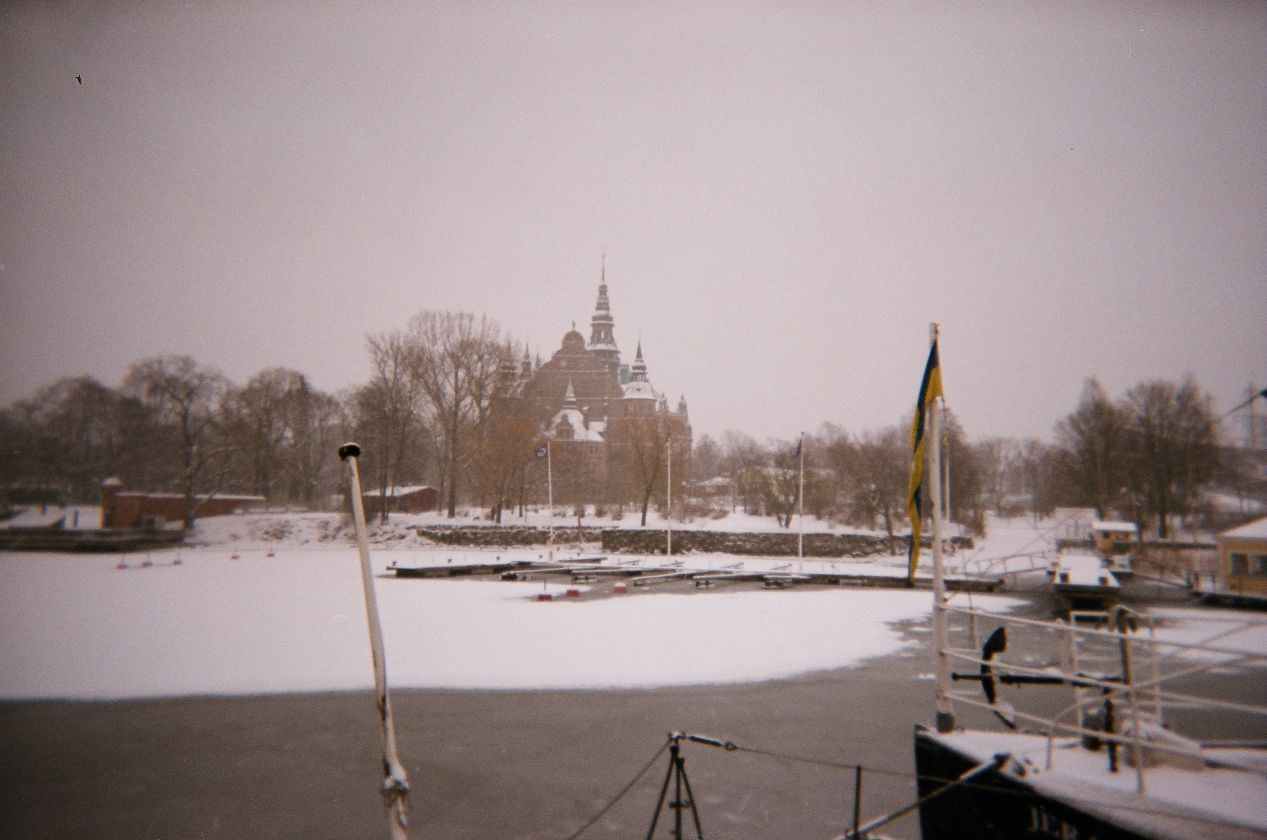


I started out this day by circling around the Östermalm district of Stockholm and crossing over to the island of Djurgården. This is an area known for its park lands (as the name would suggest) and home to a series of historical buildings and museums. It's one of the main tourist areas of the city and I planned to spend a few hours exploring it. However, the weather wasn't particularly cooperating on this day and there were few people strolling about on the island. I walked past the Nordiska Museet, the museum dedicated to Swedish history, but ultimately didn't end up going inside. Then I passed by Skansen, the open-air Swedish history museum, only to find that it was buried under snow and closed for the winter. Once place that I did stop to visit was the Vasa Museum (Vasamuseet), home to the 17th century Swedish warship known as the Vasa that sank in 1628. It's been raised from the harbor floor and restored back to something approaching its original glory, and the ship is an incredible sight to see. Unfortunately, it was dark enough inside that my crummy disposal camera completely failed to capture any images of the ship. All of the ones that I took just came back with black shadows, impossible to see anything. Very annoying indeed, sigh. I'll have to link here to an image I pulled off of the Internet, and hopefully one day I can go back to Stockholm with a proper camera to take some more pictures.


After leaving the Vasa Museum, I crossed back over to the mainland and then headed across another bridge, this time walking into the historic heart of the city of Stockholm. This is located on another island officially called Stadsholmen but more generally referred to as Gamla Stan, which translates as "Old Town" in Swedish. Gamla Stan dates back to the 13th century originally and consists of narrow, cobbled streets with buildings still retaining a distinct medieval feel to them. It is also home to many of the oldest and most distinguished institutions of the Swedish nation, including the Parliament Building (Riksdagshuset) and Royal Palace (Kungliga slottet) pictured above. Like many of the historic palaces across Europe, this is no longer the current residence of the Swedish royal family, but rather a museum open to the public. The current building was a replacement for a medieval fortress that largely burned down in a 1697 fire, and therefore dates from the first half of the 18th century. The architectural style is Baroque, common across Europe in the early decades of the 1700s. I went on a short tour of the building's interior, however they did not allow photography of the interior at the time of my visit and therefore these pictures of the exterior are all that I have to show. It's an impressive place to visit and certainly a must-see destination while in Stockholm.


Sitting close by the Royal Palace is the Church of St. Nicholas, a building more generally known as the Storkyrkan ("Great Church" in Swedish). The Storkyrkan is the oldest church in Stockholm and essentially the head of the Lutheran Church in Sweden, more or less the national cathedral of the country. It is most famous for a dramatic wooden statue of St. George and the Dragon dating to the late 15th century, supposedly housing the relics of a half dozen different saints. I loved the interior of this building, laid out in traditional Gothic style but with BRICK columns on the interior instead of stone to give it a very distinctive appearance. I took a whole bunch of pictures in here... and none of them turned out, with my cheap disposable cameras being completely unable to handle the low light conditions of the interior. Argh! As such, I'm forced to cheat again and provide an Internet image of the inside. The only picture that turned out was a single snapshot of the exterior, and it wasn't even a particularly good picture. Bah.
The other image above does a much better job of capturing the narrow, twisting streets of Gamla Stan. Even in the middle of the day these streets are dark and cramped, and it's easy to believe that you've stumbled onto the set of a movie or television show based in the Middle Ages. Today Gamla Stan contains lots of shops and restaurants that cater to tourists, as well as high-end stores with designer fashions. I ate lunch in a small cafe and it was a pleasant experience to sit by the window eating a hot meal while watching the snow fall outside. The weather was turning nasty again outside and the snow was really starting to come down. While it made for some pretty pictures, it also meant that there were fewer places remaining open that would normally attract visitors to the city.

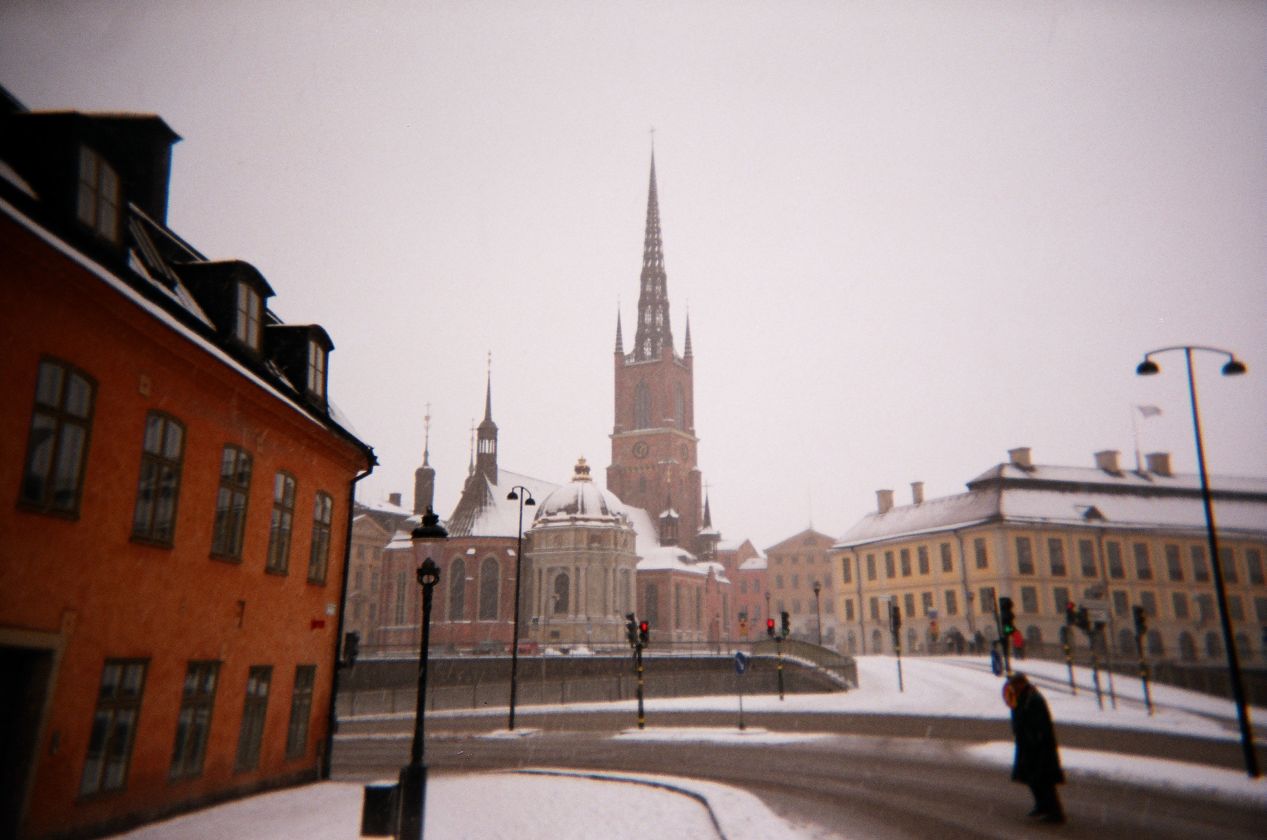


The snow was coming down so hard outside that I could barely see by the time that I was finished with lunch. It was coming down in sheets as I passed the Riddarhuset (House of Nobility), the stately building above that originally functioned as Sweden's equivalent of the House of Lords, and today still continues to represent the interests of the nation's nobility. (Yes, Sweden still has a monarchy and an aristocracy for those who didn't know, although of course it is a democratic country where these things are purely symbolic.) Rising above me on the western end of Gamla Stan was the spire of the Riddarholmen Church, the burial location for Sweden's royal family. There are monarchs as far back as Magnus III (died 1290) who have the Riddarholmen Church as their final resting place. The square out in front of the building was deserted on this afternoon, with a few inches of snow coating the cobblestones. I was right next to the waters of the harbor here, and I walked over to see the view. Looking across at the Södermalm on the other side, everything seemed to be a mixture of the colors white and gray. The sky above was still thick with leaden clouds, the harbor had chunks of ice scattered about its surface, broken up by the ships passing through, and snow continued to fall from the sky and coat everything under a blanket of white. It was an impressive sight, and I would have stayed here longer to take in the view if it hadn't been so blasted cold outside. (It was roughly -10 Celsius / 15 Fahrenheit at the time for reference.)

At this point, it was beginning to get late and I had to head off to my next destination. Not to a hotel room for the night, but over to the station to catch a train heading north. Very far to the north. I was taking an overnight 16 hour train to the town of Kiruna, up in the northernmost region of Sweden beyond the Arctic Circle. Why in the world did I want to head up there? I had two purposes in mind for this journey, aside from the inherent awesomeness of being able to say that I had traveled into the Arctic during the winter. The first goal was to visit the Ice Hotel, famously located a short distance outside of Kiruna and carved completely out of blocks of ice. The other goal was to try and see the aurora borealis, the Northern Lights, which would require a bit of good luck to spot. I was only going to spend one night and Kiruna and that would make it a total crapshoot as to whether they were visible at all. Still, the winter is the best time of year to see the Northern Lights, and by heading into such a remote area I wasn't going to have to worry about light pollution. I slept on the train as best I could throughout the night and awoke the next morning to find myself passing through an endless forest of evergreen trees, with the train spending a full hour between one small town and the next. I was heading off into real wilderness here, up near the top of the world.


I arrived around noon in Kiruna at the local train station where a sizable number of travelers disembarked alongside me. Kiruna is the largest town for a long distance in any direction, and it is best known for the iron mining industry that takes place in the vicinity. At the time of writing, Kiruna had about 20,000 residents and it was the largest town in northern Sweden. I didn't know this when I visited, but the town itself is slowly moving a few kilometers to the east because the gigantic underground mines are making the land underneath the town structurally unsound. The climate here was what one would expect for a remote town above the Arctic Circle, bitterly cold (average February low temperature is about -18 Celsius / 0 Fahrenheit) and with mountains of snow lying about. Anywhere that wasn't shoveled or plowed had several feet of snow and was virtually impassable. Despite all of that I found the town center to be a cozy little place, with a handful of small stores and ice sculptures on display. I purchased a reindeer antler here as a souvenir which I still have today.

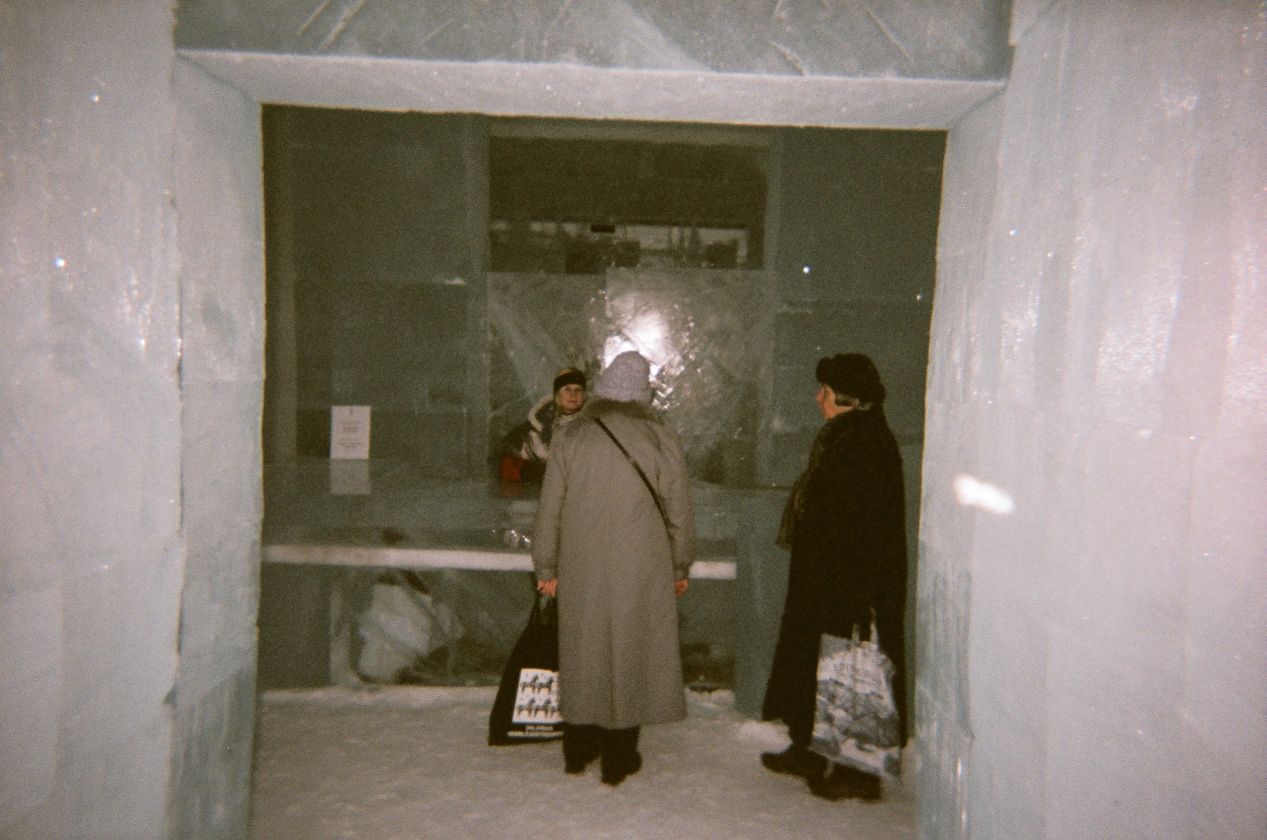


I checked into my hotel in Kiruna, which had maybe five other guests in the whole place this time of year, and then caught a local bus that headed off to the Ice Hotel. Located just a few miles away in the tiny hamlet of Jukkasjärvi, the Ice Hotel is a world-famous attraction due to its unique nature. There are other ice hotels around the world that were inspired by the one here in northern Sweden, but this was the original such building to exist. The Ice Hotel was first constructed in 1990, and it is rebuilt using a different design every single year using ice blocks cut from the nearby river. It was snowing again when I arrived, and the softly drifting white flakes gave the place an even more magical atmosphere. It's a strange place to visit, with literally everything made out of ice: the reception desk, the individual rooms, the bar, the church, etc. The Ice Bar was a particularly neat place, with no need to cool any of the drinks inside. I think they actually needed to warm some of them up to keep the drinks from freezing. The temperature inside the Ice Hotel was below freezing, kept at roughly -5 Celsius / 25 Fahrenheit. Visitors definitely needed to keep their outside gear on at all times.

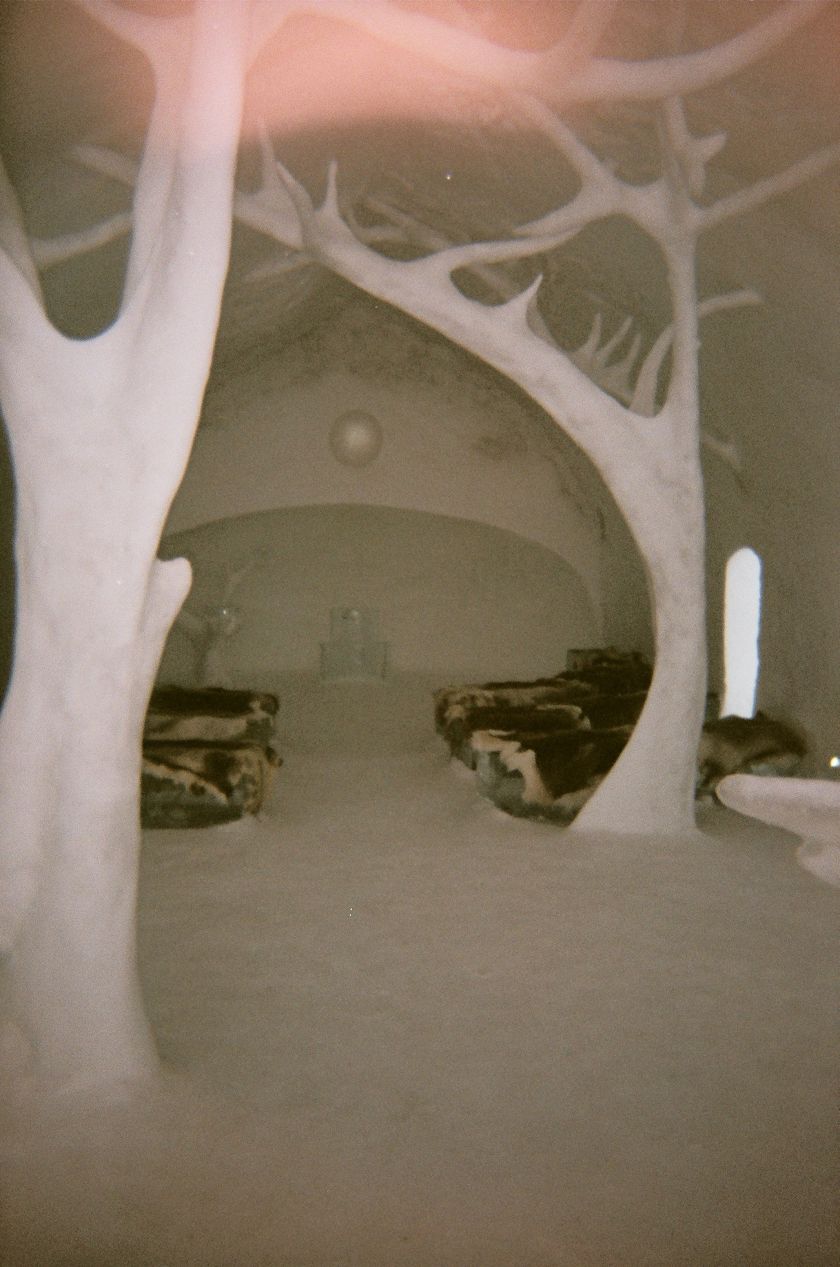


There were all kinds of unique rooms in the Ice Hotel, with each of the roughly two dozen rooms having a different design. Some of them had bedrooms located inside crystalline pillars, or resting among the moon and the stars. I remember that in one of them the visitor had to climb up a spiralling ice staircase to a second floor where the bed itself was located. Others were considerably more bizarre, with one having a false elevator that went nowhere and another having strange modern art inspired sculptures. All of the beds were made out of ice and covered with heavy blankets to make them more comfortable. The Ice Hotel is a very expensive place to stay, but I have to say that the beds didn't look like they would be a good place to sleep at all. Even with fireplaces in most of the rooms to provide additional heat, the whole place was bitterly cold. I think this is the kind of place where it's better to visit than to stay overnight.
That night, I left my hotel and walked out of Kiruna proper into the hills north of the town. There were a series of trails that looked to be used for cross country skiing and snowmobiles, and I was able to trudge along them until I was a mile or two out of the town. I climbed up one of the hills out there to the top where I sat down and waited to see if the Northern Lights would appear. I was in luck: sure enough, there they were up in the sky. While this wasn't a particularly spectacular night for the auroras, I was able to see a series of them moving across the night sky high up in the atmosphere. All of the lights that I saw were green, which is apparently the most common color for the auroras. The best way that I can describe the Northern Lights was a series of wispy green curtains moving along the sky, like translucent sheets of fabric being blown on an invisible wind. Even on a night where the auroras weren't showing up especially well, they were still quite beautiful to behold. Obviously I don't have any pictures of them, although I did try one or two shots without really expecting them to take. If these disposable cameras couldn't shoot the inside of a church, they weren't going to be able to capture a filmy light source up in the sky in otherwise near-total darkness. I can only go by my memory here, but yes, I really was fortunate enough to see the Northern Lights. 

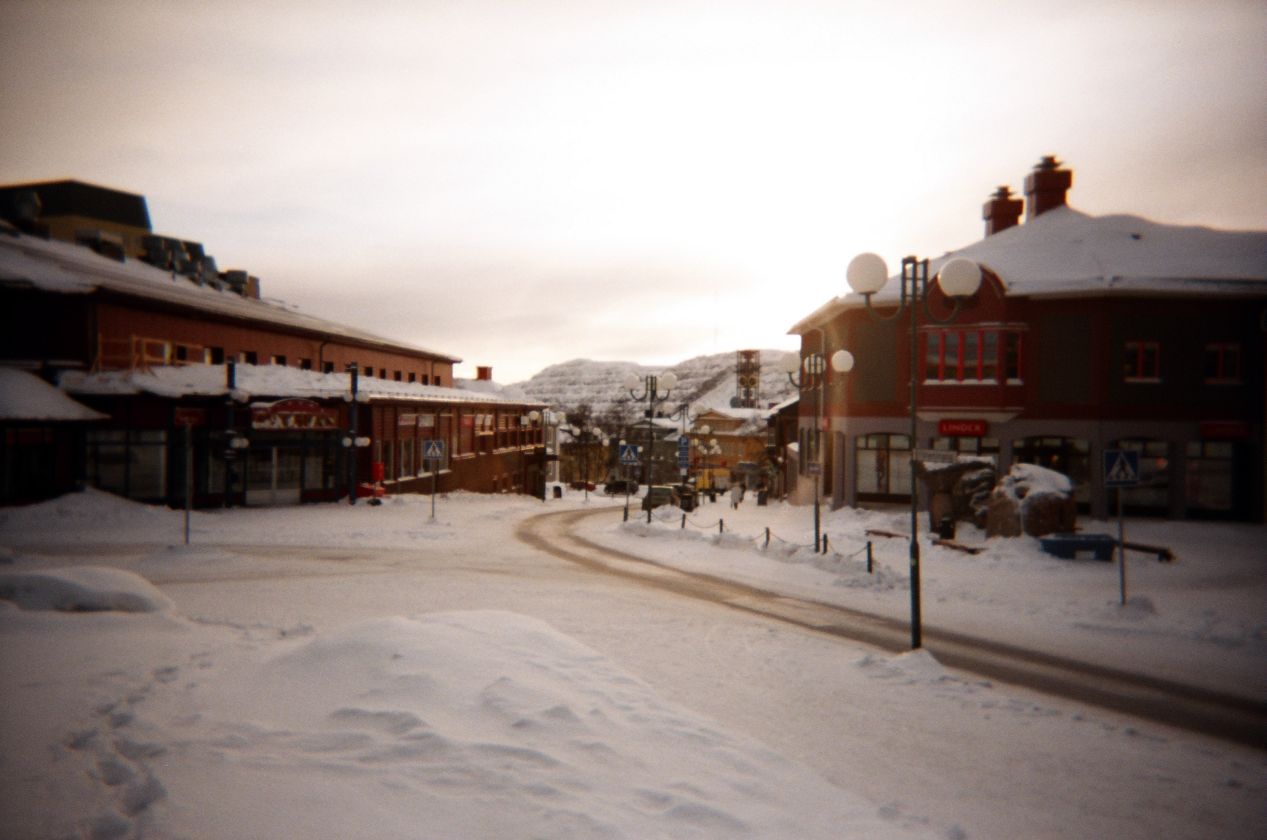


The following day was a bit of an anti-climax. My train back to Stockholm wasn't leaving until the evening, and I had a day to kill in Kiruna before returning. During the summer there are lots of tours to see here, tours down into the iron mine or tours with local sled dogs, that kind of thing. I couldn't find anything like that operating on this particular day in late winter, and lacking any Swedish language knowledge, I was hesitant to do too much asking around. Instead I spent more time exploring the town of Kiruna, walking about and poking into some of the attractions. The most noteworthy building was the church, the impressive wooden structure known as the Kiruna Pastorat. It was built in the early 20th century and is constructed entirely out of wood, with a separate bell tower out in the front. I took pictures of the interior but of course they didn't turn out either; here's an Internet picture again so that you can see what it looked like. I also popped into several different stores, and spent a few hours in the library reading some of the English-language books. Hey, it was nice and warm inside! I keep mentioning this, but it was REALLY cold in Kiruna, even with the six layers of clothing that I was wearing.
At the end of the day, I took a few pictures of the town framed by the setting sun. That last picture shows the huge hill of one of the iron mines in the distance, with the sun setting behind its bulk. I caught the evening train back to Stockholm, sleeping again overnight on the 16 hour train ride, and then finally took another plane back to London. It was an incredible trip and one that has long stuck in my memory in the years since. I love the fact that I had the chance to see two different parts of Sweden in the winter, and I'd love to return during the summer to see how different everything would look. My one regret is that I lost my camera at the outset of the trip and had to rely on those horrible disposable cameras to retain any images at all. Still, it could be worse: I could have lost the camera at the very end of my trip and had nothing to show for the journey at all.
I hope you enjoyed reading about this unusual venture. As always, thanks for stopping by the website.



